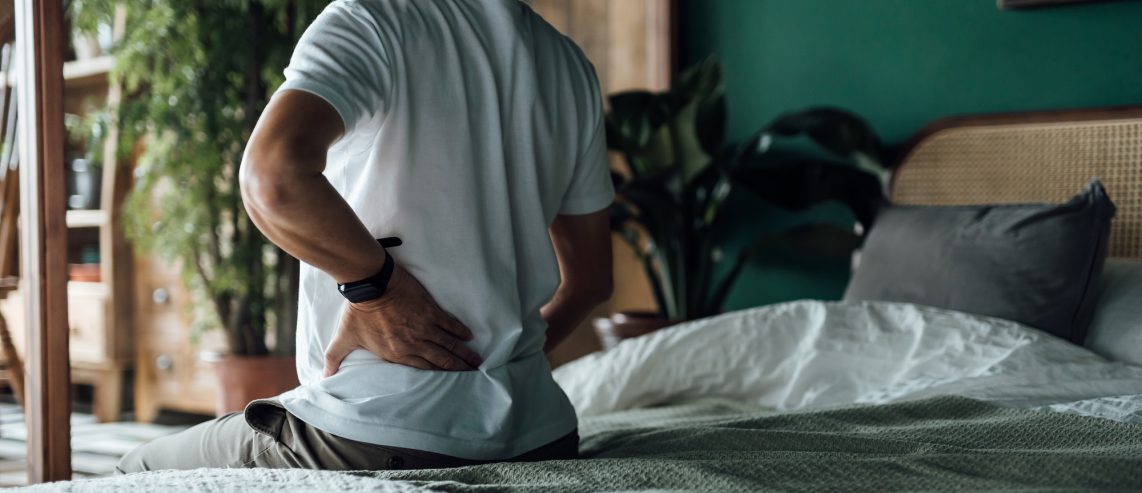Sacroiliac (SI) joint pain usually hurts in your low back and buttocks. It’s one of the major causes of low back pain.
If your low back hurts after prolonged sitting, it could be your SI joint. Also, it is not uncommon for women to have SI joint pain during and after pregnancy.
The physiatrists at the UPMC Department of Physical Medicine and Rehabilitation (PM&R) have experience diagnosing and treating SI pain. This matters, because research shows that SI pain is often underdiagnosed.
Never Miss a Beat!
Subscribe to Our HealthBeat Newsletter!
Thank you for subscribing!
You can now select the specific newsletters you'd like to receive.
You are already subscribed.
Subscribe to more newsletters in our email preference center.
Sorry, an error occurred. Please try again later.
Get Healthy Tips Sent to Your Phone!
What Is Your Sacroiliac Joint?
You have two SI joints — one on each side of your spine.
These joints are between your lower back and your hip bones, where your sacrum meets your ilium. The sacrum is the triangle-shaped bone that sits at the bottom of your spine (just above your tailbone.) The ilium is part of your pelvis.
In addition to the back muscles, ligaments — which are strong bands of tissue — hold the bones of the SI joint in place. These ligaments add stability to the pelvis and allow the joints to move as they should.
The SI joint is part of a kinetic chain that keeps you upright, helping to support the weight of your body.
What Causes SI Joint Pain?
Because you use your SI joint in many day-to-day movements, it’s vulnerable to injury. Some causes of SI joint pain and inflammation include:
- Performing activities that involve twisting, bending, or heavy lifting (like swinging a golf club, gardening, or shoveling snow).
- Trauma or injury to your lower back area.
- Osteoarthritis, which wears down the cartilage in your joints.
- Ankylosing spondylitis (AS), a kind of inflammatory arthritis caused by an autoimmune disease that targets the spine.
- Inflammatory bowel disease, such as ulcerative colitis or Crohn’s disease.
- Poor posture.
- Periods of prolonged sitting or standing, especially on uneven surfaces.
- Ligaments that have become loosened due to pregnancy.
Sacroiliac Joint Pain Symptoms
People experience SI joint pain differently. This is one of the reasons it can be difficult to diagnose. Some of the symptoms clinicians look for include:
- Localized pain and stiffness that often occurs in the buttock area. The pain and stiffness are often just on one side of the body, but they may occur on both.
- Pain in the hips or pelvis. This can feel like weakness, numbness, or even burning.
- Trouble bending or twisting your lower back.
- Pain after sitting for a long time.
- A feeling of being “out of alignment.”
Sacroiliac Joint Pain Treatments
Clinicians can’t easily test the range of motion for your SI joint. They usually diagnose SI problems by taking your medical history and asking questions about your pain and activities. Common treatments for SI joint pain include:
- Ice and heat: When the pain first flares up, use ice or a cold pack for 20 minutes, every three to four hours. When it becomes more manageable, use a heating pad or heat wrap.
- Over-the-counter medication: Nonsteroidal anti-inflammatory drugs (NSAIDs), such as ibuprofen, naproxen, and aspirin, can help reduce swelling and pain. Topical
agents like a lidocaine patch, NSAID gel, or ointments can also help with
symptoms. Always ask your health care provider about which medications are safe for you. - Muscle relaxants: Your health care provider may also prescribe this stronger medication to help with pain.
- Joint injections: Some people may benefit from pain-relieving injections into the SI joint.
- Orthotic inserts: Shoe inserts can help if the cause of your SI pain is a leg-length discrepancy.
- Physical therapy: A physical therapist can guide you through exercises to stretch and strengthen muscles around the SI joint.
- Massage therapy: Some people say that massage therapy helps relieve low back pain, including SI joint pain.
For more information about the UPMC Department of Physical Medicine and Rehabilitation or to make an appointment, call 412-692-4400 or visit our website.
Editor's Note: This article was originally published on , and was last reviewed on .
About Physical Medicine and Rehabilitation
At UPMC, we strive to improve your function after injury or illness. We help people recover from functional, pain-related, and neurological conditions, with both inpatient and outpatient care available. We are dedicated to providing you with exceptional clinical care and focused on developing new technologies and treatments to help you achieve mobility and maintain independence. Find a provider near you.
